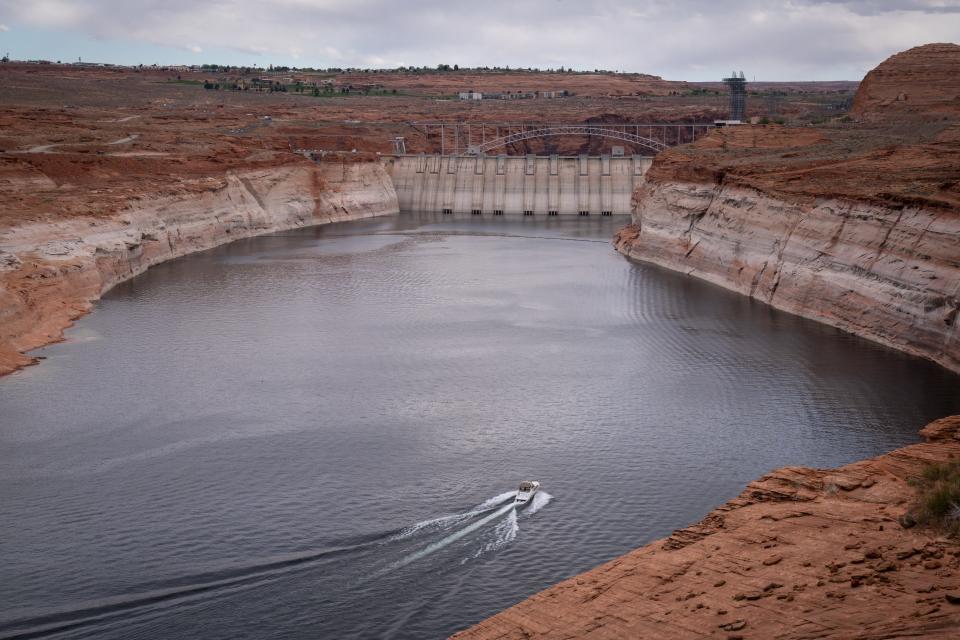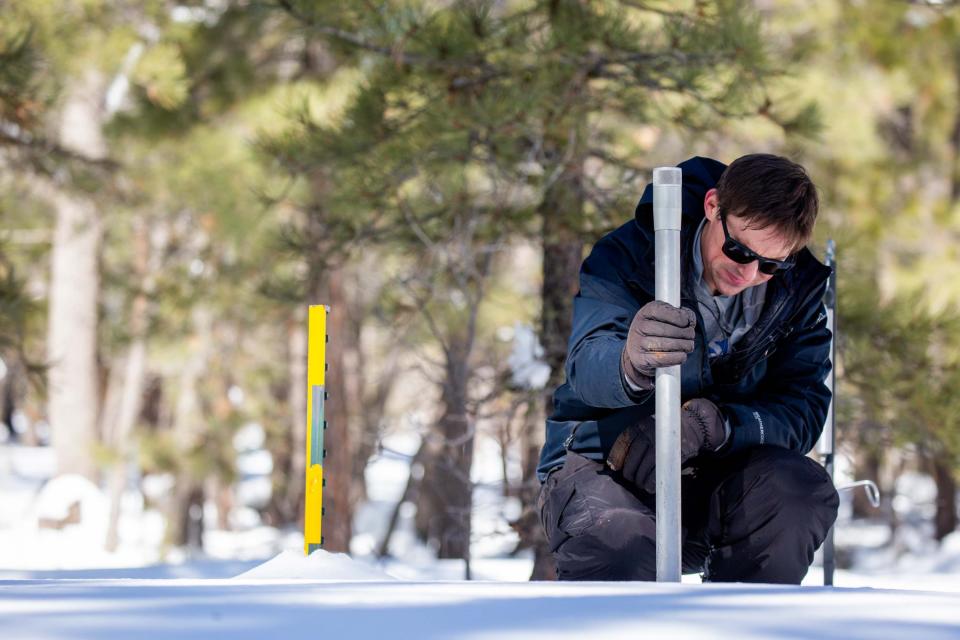A once-promising Colorado River forecast is downgraded after mediocre April snowfall
A dry April around the Colorado River Basin melted hopes for a second-straight banner year of big runoff to swell Lake Powell’s reservoir storage, government hydrologists say.
The result is a likely holding pattern for drought responses over the next two years, according to the U.S. Bureau of Reclamation. Water levels in Lake Powell and Lake Mead are unlikely to rise as they did after the strong snowpack that accumulated over the 2022-2023 winter, but are also unlikely to tip the Southwest into a new tier of water austerity measures.
The mountain snow season started out dry, came on strong in the middle, and came to an abrupt standstill in April.
“We’ve had kind of a yo-yo in regards to precipitation and snowpack,” Reclamation hydrologist Heather Patno told members of a Glen Canyon Dam Adaptive Management Program working group on Wednesday.
More than 40 million people rely on the Colorado River for water in cities and on farms in seven states, including Arizona. Drought restrictions have not affected water users in homes and businesses, but have curtailed the flow to some farmers, especially in Pinal County.

With the exception of the Colorado headwaters and Arizona’s Verde River, most areas of the seven-state watershed experienced below-average April snow and rain, according to the Colorado Basin River Forecast Center. What had generally been above-average snowpack water content throughout the region in late-winter turned toward normal or below average as meltwater started flowing toward Lake Powell.
“April precipitation as a percent of average was quite poor across most of the region,” National Oceanic and Atmospheric Administration hydrologist Cody Moser said during the forecast center’s monthly briefing. Much of the watershed experiences just half to 70% of normal April precipitation.
Snowpack numbers drop during a drier April
For the water year that began in October, total precipitation in areas flowing toward Lake Powell stood at about 97% of the 30-year average this month, he said.
A relatively dry month above the big reservoir had reduced an April 1 snow-water equivalent reading that was 113% of the median to just 89% by May 1. Snow-water equivalent describes the amount of water that would result from melting snow.

Reclamation, which manages Powell’s releases past Glen Canyon Dam, now predicts the water flowing toward the reservoir through the end of runoff season in July will come in at 81% of average, totaling 7.9 million acre-feet. With the agency set to release 7.48 million acre-feet toward Lake Mead this year, Powell’s storage capacity is not expected to change much.
It is currently 34% full and most likely will end the year at 37%, according to the agency’s calculations.
This middling outlook stands in contrast to a year ago, when big snows led Reclamation to predict flows at 172% of average, which gave both Powell and Mead reprieves from disaster built up over two decades of drought.
Negotiating long-term guidelines
While this year’s meltwater is unlikely to buoy the reservoirs much further, a year that doesn’t further deplete them can be viewed as a success. If the current predictions hold up, the agency projects that emergency water conservation measures adopted this year in the Southwest will keep supplies stable for at least a couple of years. Officials announced in March that the negotiated plan would keep 3 million acre-feet of water in storage through 2026. The agency signed the plan this month.
To ensure stability beyond that, the states, tribes and federal officials are negotiating longer-term guidelines that will mandate further water savings unless a wet streak refills the reservoirs to capacity, a level not seen yet in this century. The U.S. Interior Department is set to propose its chosen guidelines by year’s end.
Within Arizona, the Salt River Project’s outlook for water supplies is strong for the second year in a row. The metro Phoenix supplier said its Salt and Verde watershed reservoirs entered May at 93% of capacity.
Brandon Loomis covers environmental and climate issues for The Arizona Republic and azcentral.com. Reach him at brandon.loomis@arizonarepublic.com.
Environmental coverage on azcentral.com and in The Arizona Republic is supported by a grant from the Nina Mason Pulliam Charitable Trust.
Sign up for AZ Climate, our weekly environment newsletter, and follow The Republic environmental reporting team at environment.azcentral.com and @azcenvironment on Facebook and Instagram.
You can support environmental journalism in Arizona by subscribing to azcentral.com today.
This article originally appeared on Arizona Republic: Dry spring dampens hope for another big water year on the Colorado

